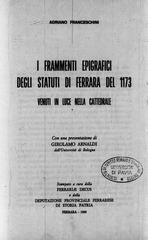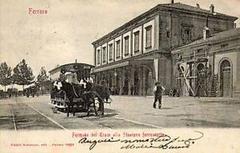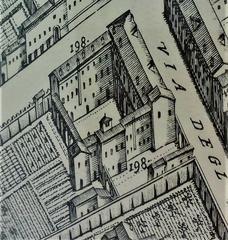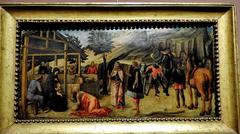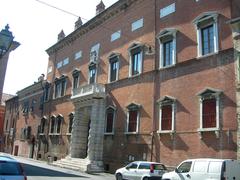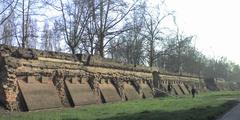Monumento a Paolo V in Ferrara, Italy: Visiting Hours, Tickets, and Travel Guide
Date: 14/06/2025
Introduction
The Monumento a Paolo V, located in Ferrara, Italy, stands as a distinguished testament to the city’s fascinating shift from Este dynasty rule to Papal authority in the early 17th century. Erected in 1618 within the city’s formidable pentagonal fortress, this marble statue of Pope Paul V (Camillo Borghese) is both an emblem of spiritual guardianship and a marker of Ferrara’s layered political and cultural history (MuseoFerrara; Treccani).
This comprehensive guide provides essential visitor information, including opening hours, ticketing (noting free admission), accessibility, and tips for exploring nearby attractions like Estense Castle and Palazzo dei Diamanti. Whether you are a history enthusiast, art lover, or casual traveler, this resource ensures a rewarding visit to one of Ferrara’s most significant landmarks (MuseoFerrara; Visit Ferrara).
Table of Contents
- Introduction
- Historical Background
- Visiting Information: Hours, Tickets, Accessibility
- Nearby Attractions and Travel Tips
- Artistic and Architectural Features
- Political and Symbolic Significance
- Restoration and Preservation
- Practical FAQs
- Visual Gallery
- Conclusion and Recommendations
- References
Historical Background
After the Este dynasty ended its long rule of Ferrara in 1598, the city became part of the Papal States under Pope Paul V (1605–1621). His governance was marked by efforts to assert Papal sovereignty and strengthen the city’s defenses. The pentagonal fortress, where the Monumento a Paolo V was installed in 1618, was a practical and symbolic assertion of this control. The marble statue, crafted by Giovanni Lucca Genovese and Serafino Colli, shows the pope in full pontifical regalia blessing Ferrara—an image that reassured the city of both divine protection and Papal authority (italia.it; Treccani).
The fortress itself was a feat of military engineering, featuring five bastions, barracks, armories, and other defensive structures, reflecting the latest advances of the era (MuseoFerrara).
Visiting Information: Hours, Tickets, Accessibility
Visiting Hours:
- The Monumento a Paolo V is accessible year-round, 24/7, as it is located in a public outdoor park. Daylight hours are recommended for the best experience and photography.
Tickets:
- Admission is free; no tickets or reservations are required. Guided tours of the surrounding fortress area are available through local providers for a small fee (usually around €5 per person). Advance booking is advised for tours.
Accessibility:
- The monument and its park setting are wheelchair accessible, with paved paths and ramps. Benches and shaded areas are available for comfort. Public transportation and bike rentals are convenient options for reaching the site.
Nearby Attractions and Travel Tips
While visiting the Monumento a Paolo V, you are steps away from some of Ferrara’s most celebrated sites:
- Estense Castle: A Renaissance fortress at the heart of Ferrara (The Crazy Tourist).
- Palazzo dei Diamanti: Renowned for its diamond-pointed façade and art exhibitions.
- Ferrara Cathedral: A masterpiece of Romanesque-Gothic architecture.
- City Walls: A 9 km circuit of Renaissance walls ideal for walking or cycling (Nomads Travel Guide).
- Jewish Ghetto: One of Italy’s most important historic Jewish quarters (The Travel Folk).
Travel Tips:
- Getting There: Ferrara is easily reached by train from Bologna and Venice. The historic center is pedestrian and bike-friendly.
- Best Time to Visit: Spring and early autumn offer pleasant weather and fewer crowds.
- Visitor Passes: Consider the Ferrara Card or MyFE Card for discounts at other attractions (Inferrara).
Artistic and Architectural Features
The Monumento a Paolo V is an early Baroque work by Giovanni Lucca Genovese and Serafino Colli. It depicts Pope Paul V seated in pontifical robes, raising his hand in blessing. The statue’s dignified posture, expressive features, and finely carved drapery exemplify the Baroque focus on drama and authority.
The monument’s placement on the embankment between the Baluardo di Santa Maria and Baluardo di San Paolo bastions integrates art with military architecture. The contrast of white marble against red brick fortifications makes it a focal point within the green park (Ferrara Terra e Acqua).
Political and Symbolic Significance
The monument was intended as a clear message of Papal legitimacy and power after the end of Este dynastic rule. Pope Paul V’s blessing posture signals spiritual guardianship and the assertion of Papal rule. The fortress and statue together were physical manifestations of new governance and a reminder of the city’s place within the Papal States (Wikipedia).
Restoration and Preservation
After the fortress lost its military role in the 19th century, much of it was dismantled. The statue itself was destroyed and buried during the Napoleonic era, restored by the Austrians, and finally returned to its current site after major restoration in 2003. The city’s ongoing conservation efforts, bolstered by Ferrara’s UNESCO World Heritage status, ensure the monument’s preservation (MuseoFerrara).
Today, the fortress’s two surviving bastions and the monument are part of a park that is both a historical landscape and a tranquil retreat for visitors and locals alike.
Practical FAQs
Q: What are the opening hours?
A: The monument is open 24/7, year-round.
Q: Is there a ticket fee?
A: No, visiting the monument is free.
Q: Are guided tours available?
A: Yes, local providers offer tours of the monument and nearby fortifications.
Q: Is the site accessible?
A: Yes, paved paths and ramps make the area wheelchair accessible.
Q: What is the best time to visit?
A: Spring and autumn provide mild weather and optimal light for photography.
Visual Gallery
For more images and virtual tours, visit the MuseoFerrara website.
Conclusion and Recommendations
The Monumento a Paolo V is not just a striking work of art, but a living piece of Ferrara’s story—embodying the city’s transition from Este splendor to Papal strength, and its ongoing commitment to heritage and culture. Its free, year-round access, central location, and proximity to other major attractions make it ideal for any Ferrara itinerary.
Plan your visit during the spring or autumn for the best experience, and consider combining your exploration of the monument with guided tours or the Ferrara Card for a deeper dive into the city’s Renaissance and Baroque treasures. Don’t forget to download the Audiala app for exclusive tours and travel tips, and share your journey using #MonumentoPaoloV and #VisitFerrara.
References
- MuseoFerrara – Monumento a Paolo V
- MuseoFerrara – Fortress and Walls
- Treccani – Paolo V Biography
- Ferrara Terra e Acqua – City Walls
- ATX Fine Arts – Ferrara and the Renaissance
- Visit Ferrara – Official Portal
- Inferrara – Events and Passes
- Nomads Travel Guide – Ferrara
- The Crazy Tourist – Ferrara Guide
- Not Your Mama’s Italy – Ferrara Five-Day Guide
